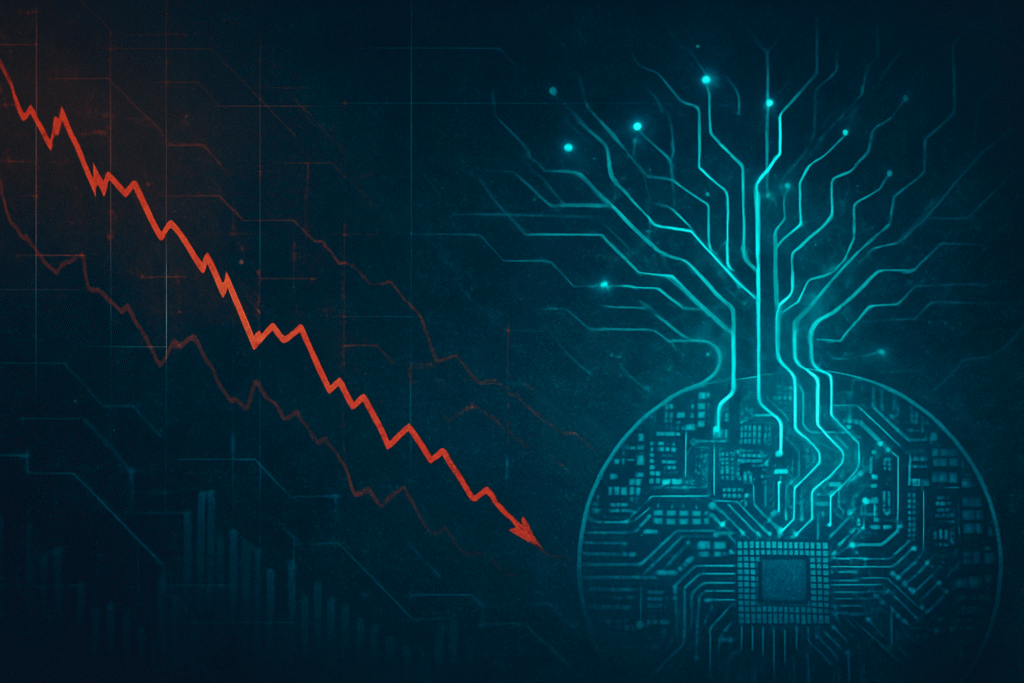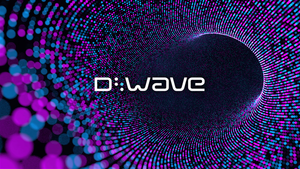
San Francisco, CA – November 4, 2025 – The technology sector, a beacon of innovation and seemingly boundless growth for much of the past decade, is currently navigating turbulent waters. A broad market sell-off, coupled with increasingly dire warnings of a deeper downturn, has sent ripples across global exchanges. This recalibration is not merely a fleeting dip but a significant re-evaluation of high-flying valuations, particularly within the artificial intelligence (AI) space, and is poised to reshape the landscape for even the most entrenched players, with the semiconductor industry feeling particularly acute pressure and opportunity.
The immediate significance of this trend is profound. With "Big Tech" stocks comprising a substantial portion of overall market indices, a sustained sell-off risks triggering a broader market contagion. Capital is being reallocated from riskier tech assets to more stable sectors, accelerating a wider economic slowdown. Smaller, growth-oriented technology companies, heavily reliant on external funding, face heightened vulnerability due to increased borrowing costs and a reduction in venture capital inflows. The highly interconnected nature of the tech supply chain means financial struggles or slowdowns among major tech players could cascade, impacting partners and industries globally.
Unpacking the Economic Headwinds: A Confluence of Factors
The current market apprehension stems from a confluence of macroeconomic pressures, shifting monetary policies, and evolving investor sentiment. Central to this downturn are persistent inflation, cautious interest rate policies, a deteriorating global economic outlook, and a pervasive "risk-off" mentality among investors.
Throughout late 2024 and early 2025, central banks, including the Federal Reserve, maintained higher interest rates for longer than initially anticipated to combat stubborn inflation. While the Federal Reserve did implement a 25-basis-point rate cut on October 29, 2025, bringing its key interest rate to a target range of 3.75% to 4%, Chair Jerome Powell's accompanying statements were perceived as "hawkish." Powell emphasized that a further rate cut in December was "not a foregone conclusion" due to ongoing inflation concerns. Higher interest rates inherently dampen the valuations of growth-oriented technology stocks by increasing borrowing costs and discounting future earnings more heavily, making them less attractive.
Inflation remained stubbornly above the Federal Reserve's 2% target, with the core Personal Consumption Expenditures (PCE) index rising to 2.9% annually in July 2025. This, compounded by Trump-era tariffs on imports, has strained tech sector valuations. While inflation has moderated in the U.S. and India, Europe continues to grapple with high energy prices, hindering cloud adoption. Rising wages in major tech hubs are also pressuring profit margins for giants like Google (NASDAQ: GOOGL) and Meta (NASDAQ: META).
The global economic outlook for late 2025 is characterized by significant caution. Dan Niles of Niles Investment Management has warned of a potential 10% market sell-off, attributing it to "forward-pulled demand," deteriorating economic indicators, and policy missteps. U.S. payroll additions slowed, the ISM Services PMI contracted, and wage growth stagnated. Some analysts suggest a services sector slowdown could push the economy into recession by late 2025. An ongoing U.S. government shutdown has further exacerbated global uncertainty. Investor sentiment is largely "risk-off," leading to a shift away from equities towards "safe-haven" assets. This apprehension is intensified by escalating geopolitical tensions, trade wars, and a critical re-evaluation of lofty valuations, particularly within the burgeoning AI sector. Concerns about an "AI bubble" and elevated price-to-earnings (P/E) ratios have become prominent, leading to profit-taking and a reassessment of future growth prospects for many tech companies. Jamie Dimon, CEO of JPMorgan Chase (NYSE: JPM), and the Bank of England have issued warnings about a potential market crash or "sudden correction" driven by high AI company valuations.
Semiconductor Crossroads: AI's Lifeline Amidst Market Turmoil
The semiconductor industry, the foundational bedrock of the digital economy, finds itself at a critical juncture. While facing headwinds from the broader tech downturn, it is simultaneously experiencing unprecedented demand driven by the relentless march of artificial intelligence.
Demand for semiconductors in late 2025 is bifurcated. Traditional markets like consumer electronics, general PCs, and mobile devices are experiencing muted growth. However, the explosive demand for AI-related technologies is acting as a significant counterbalance. Generative AI and data center build-outs are the primary engines, driving a high and sustained need for advanced GPUs, high-bandwidth memory (HBM), and solid-state drives (SSDs). The non-memory data center chip market and GPU market values are projected for substantial growth. The rollout of AI-powered PCs and smartphones is also expected to drive considerable demand, with AI PCs potentially accounting for 50% of all PC shipments in 2025. The automotive sector, particularly electric vehicles (EVs) and advanced driver-assistance systems (ADAS), remains a strong growth area, using two to three times more chips than traditional cars.
Semiconductor supply chains, while showing signs of stabilization, continue to face challenges. The US-China technological rivalry remains a dominant factor, with export restrictions on advanced technologies from the US to China impacting revenue for American companies and prompting them to seek alternative suppliers. China's export controls on critical materials also introduce disruptions. Fab production is increasingly prioritizing advanced-node chips essential for AI and high-performance computing, potentially leading to continued shortages in mature-node technologies crucial for automotive and industrial applications. Building new fabrication plants (fabs) is a multi-year, multi-billion-dollar endeavor, with some projects, like Taiwan Semiconductor Manufacturing Company's (NYSE: TSM) Arizona facility, experiencing delays. Resource and talent shortages, high infrastructure costs, and vulnerabilities to natural disasters persist.
Investment in the semiconductor industry remains robust, particularly in areas driving future growth. Companies are projected to allocate approximately $185 billion to capital expenditures in 2025 to expand manufacturing capacity. Significant R&D investments are channeled into generative AI, digital transformation, and sustainable manufacturing practices. Government initiatives like the US CHIPS Act are major drivers of domestic manufacturing investment. Investor interest is heavily concentrated in AI and High-Performance Computing (HPC) segments, favoring companies at the forefront of advanced CPUs, GPUs, data center communication chips, and HBM.
Corporate Maneuvers: Navigating the AI Gold Rush and Market Correction
The current market environment is forcing strategic shifts and highlighting competitive dynamics among the leading semiconductor players.
Nvidia (NASDAQ: NVDA) remains a dominant force in the AI chip market, with strong demand for its GPUs. However, the company experienced significant stock sell-offs throughout late 2024 and 2025, driven by investor re-evaluation of its hyper-growth narrative, competitive concerns, and US-China trade tensions. Export restrictions have led to substantial revenue impacts and inventory write-downs. In August 2025, Nvidia and Advanced Micro Devices (NASDAQ: AMD) reportedly agreed to pay a 15% cut of AI chip sales revenue to the US government for export licenses to China. Despite volatility, Nvidia's stock has seen impressive gains over the past year, becoming the first company to reach a $5 trillion market cap in late 2025, and analysts remain bullish on its AI prospects. Notably, Nvidia also invested $5 billion in Intel (NASDAQ: INTC) in September 2025 for joint CPU development, a testament to the complex interdependencies within the industry.
Intel (NASDAQ: INTC) is undergoing a significant "comeback" in 2025, with its stock nearly doubling year-to-date after a challenging 2024, outperforming many peers. The company returned to profitability in Q3 2025, fueled by aggressive cost-cutting measures, including reducing its workforce by over 20% by year-end 2025, and new funding. A critical focus is the success of its 18A process technology, vital for regaining its manufacturing lead and bringing flagship PC chip production in-house. Intel holds a majority share in the server CPU market and offers cost-effective AI accelerators like Gaudi 2 and 3.
Advanced Micro Devices (NASDAQ: AMD) experienced a stock sell-off in late 2024 and early 2025 due to concerns over increasing competition from Nvidia in the AI GPU space and a potential slowdown in the broader PC and server CPU markets. Despite this, AMD reported strong Q4 2024 results driven by its data center and client segments. The company is strategically pivoting towards AI chips, with its MI350 GPU series, expected in late 2025, projected to deliver significant performance improvements for AI inference. While its projected AI GPU market share for 2025 is lower than Nvidia's, analysts anticipate strong AI revenue growth from its MI325 and MI350 series.
Broader Implications: Reshaping the AI Landscape and Beyond
This market downturn and the semiconductor industry's response have wider significance, reshaping the broader AI landscape and global technological trends. The current "risk-off mood" is prompting a recalibration of market expectations, leading to valuation resets where companies with high P/E ratios face downward pressure. Capital is observed shifting from speculative assets towards more established, profitable companies. This could lead to a more disciplined and mature tech market in the long run, where sustainable business models and clear paths to profitability are prioritized over hyper-growth narratives.
The geopolitical landscape continues to cast a long shadow. The US-China technological rivalry, with its export restrictions and reciprocal controls on critical materials, highlights the fragility of global supply chains and the increasing politicization of technology. This rivalry not only impacts revenue for major players but also accelerates the trend towards regionalization of supply chains, with significant investments in domestic manufacturing, as seen with the US CHIPS Act.
Concerns about an "AI bubble" are valid, as the rapid growth and high valuations of many AI companies have drawn comparisons to previous tech booms and busts. However, unlike some past speculative bubbles, the underlying technological advancements in AI are tangible and transformative. The challenge lies in distinguishing between genuine innovation with sustainable business models and overhyped ventures. This period of market correction could serve to weed out less viable projects, ultimately strengthening the AI ecosystem by focusing resources on truly impactful technologies.
The Road Ahead: Innovation, Resilience, and Strategic Pivots
The semiconductor industry is poised for continued financial improvement and new opportunities through 2025 and beyond. Forecasts predict an annual growth rate of 7-9% post-2025, aiming for a $1 trillion valuation by 2030.
AI is not only a demand driver but also a transformative force in chip design, with the industry exploring digital twins and AI-powered tools to enhance efficiency and accelerate time to market. The industry is moving towards more resilient supply chains, diversified sourcing, and sustainable manufacturing practices, driven by policy landscapes and environmental concerns. A "shift-left" approach to chip design and rapid expansion in advanced packaging technologies, such as TSMC's CoWoS capacity, are critical for meeting the demands of high-performance computing and AI. While a full recovery from chip shortages will take several years, partial stabilization is anticipated for 2025-2026. However, geopolitical factors, raw material availability, and evolving technology demands will continue to influence market dynamics.
Experts predict that the short-to-medium term will be characterized by ongoing challenges as investors navigate central bank policy uncertainty, persistent inflation risks, and geopolitical instability. Companies that can demonstrate strong fundamentals, efficient operations, and a clear strategic vision for AI integration will be best positioned to weather the storm and emerge stronger. The focus will shift from purely speculative growth to profitable innovation and resilient supply chains.
A New Era of Tech: Prudence Meets Progress
The current broad tech sector sell-off and market downturn warnings mark a significant turning point, ushering in a new era where prudence meets progress. The days of unchecked growth and lofty valuations based solely on future potential are being tempered by economic realities and investor caution. For the semiconductor industry, this period represents both a challenge and an immense opportunity. While traditional markets may languish, the insatiable demand for AI-driven processing power acts as a powerful catalyst, propelling innovation and investment in advanced chip technologies.
The key takeaways are clear: the market is undergoing a necessary correction, driven by macroeconomic factors and a re-evaluation of risk. The semiconductor industry, while not immune, is uniquely positioned to benefit from the AI revolution, albeit with strategic adjustments to navigate supply chain complexities and geopolitical pressures. The next few weeks and months will be crucial as companies release earnings, central banks signal their next moves, and the global economic picture becomes clearer. Investors and industry observers will be watching for signs of stabilization, further strategic pivots by tech giants, and the continued evolution of AI applications that promise to redefine our technological future.
This content is intended for informational purposes only and represents analysis of current AI developments.
TokenRing AI delivers enterprise-grade solutions for multi-agent AI workflow orchestration, AI-powered development tools, and seamless remote collaboration platforms.
For more information, visit https://www.tokenring.ai/.





